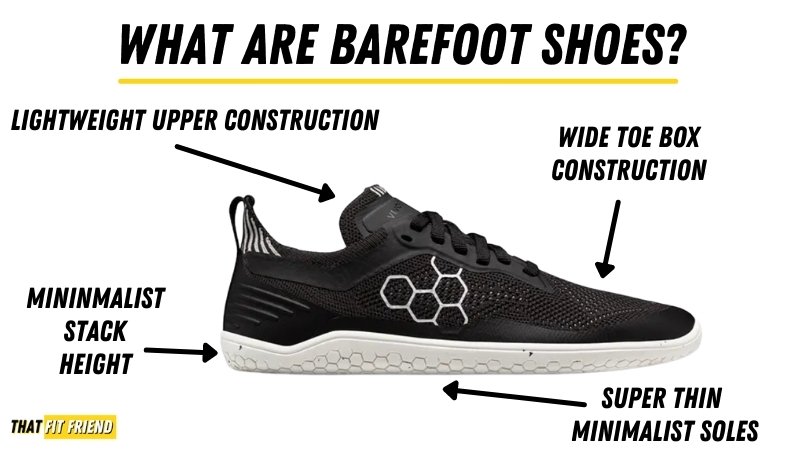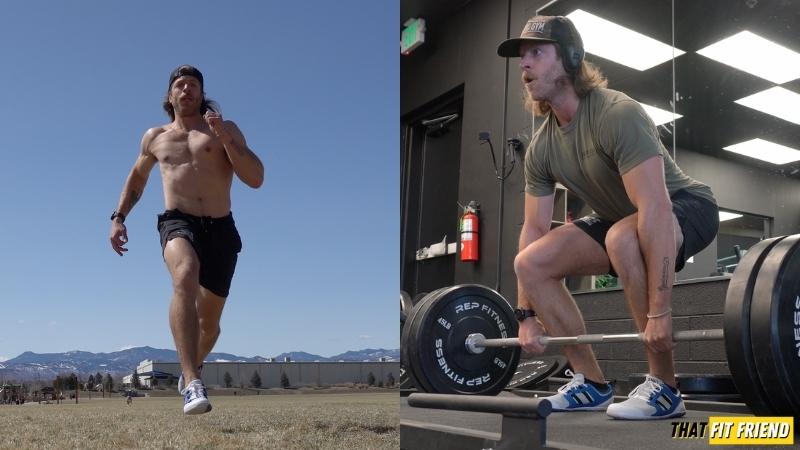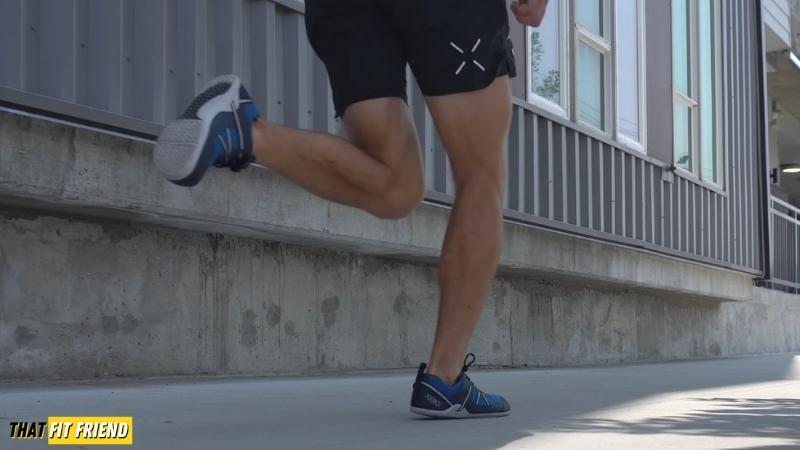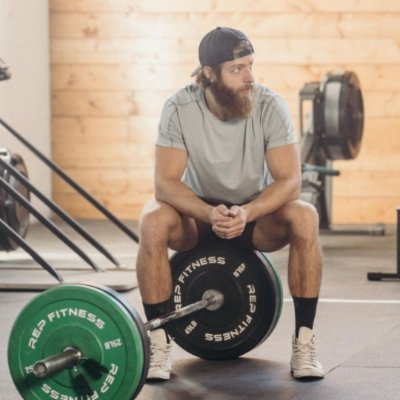As someone who rotates between training shoes and barefoot shoes for working out and daily wear, I’m constantly navigating the different environments I put my feet in. Going from traditional trainers, and normal shoes for that matter, to barefoot shoes is a pretty significant difference.
Every day I field questions on my YouTube channel about the topic of switching from shoes like cross-training shoes to barefoot shoes. Basically, I get asked a lot about acclimating to barefoot shoes and what to expect when switching.
That all being said, I wanted to put together an article and discuss some of my thoughts on what to expect when you switch to barefoot shoes.
This way, if you’re considering switching to barefoot shoes whether it be for daily wear, working out, or running, you’ll have a better idea of what to expect.
Table of Contents+
Author’s Note: This article includes a lot of my observations about barefoot shoes in both the footwear and fitness industry. This article is intended to be suggestive and observational in nature as opposed to definitive.
1. Your Barefoot Shoe Experience Will Be Individual
The first thing to expect when switching to barefoot shoes is to acknowledge that your experience will be individual with barefoot shoes. This means that your feet and interpretations of the shoes will vary based on a plethora of factors.
It’s always interesting hearing the contrast in feedback from those switching to barefoot shoes. Feedback ranges from, “My feet are so comfortable, I love these,” to “I despised the fit and feel of these and they hurt my feet.”
No experience is the same when switching to barefoot shoes and to expect your interpretations and experiences to be the exact same as your peers can be misleading.
Also, I’ve found that those who go into barefoot shoes with preconceived notions will often subconsciously validate their biases towards the footwear.
For example, let’s say you follow a variety of lifters, athletes, and others who swear by barefoot shoes. If you’re constantly seeing verbiage that shines barefoot shoes in an overly glorified and positive light, then you’ll likely go into barefoot shoes with a much more positive mindset.
This mindset that is built before wearing barefoot shoes can then blur the line of your true experiences with this type of footwear. If you go into barefoot shoes expecting them to perform and feel a certain way that is based on others’ interpretations, then they’ll likely feel how you preconceived them to.
Essentially, when switching to barefoot shoes, I’d suggest going into them with a neutral and open mindset. If you can do this, then you can more accurately gauge if barefoot shoes are right for you and if they actually align with your goals, wants, and needs.
Takehome Message: Barefoot shoes and their fit and feel for you will and should be individual. When switching to barefoot shoes, I’d suggest not building barefoot shoe biases based on others’ interpretations of barefoot shoes.
Low-key this is also something I’m (we’re all) constantly navigating in the day of social media and something I try to apply to multiple aspects of my life whether it be with my coaching, business, and everything else. It’s easy to be influenced, especially when it comes to footwear.
2. Barefoot Shoe Acclimation Times Can Vary
Once you’ve come to accept and expect that your experiences with barefoot shoes will be individual, you can then acknowledge that your acclimation time to barefoot shoes will also vary.
When switching to barefoot shoes, it’s important to understand that there will be an acclimation period with this style of footwear. Your acclimation period will vary based on a plethora of factors and how you plan to use your barefoot shoes can influence this.
Unlike most traditional shoes, your feet and ankles will need time to adjust to barefoot shoes due to the differences in ground contact, impact force, and biomechanical changes that come with their use.
For context, countless aspects can change with your movement when switching from traditional shoes to barefoot shoes. Below, are three of the biggest things that change when switching to barefoot shoes.
- Your ankle range of motion will change for walking, running, and other movements. Generally, there will be a greater range of motion demand when walking barefoot or using barefoot shoes compared to thicker midsole shoes with higher heel-to-toe drops.
- Your feet will interact differently with the ground. A great example here is someone who is going from having constant arch support to none. In this case, the demands on the foot and its three arches will change fairly drastically when switching to barefoot shoes.
- Your walking and running gait will change. Whether you’re walking or running, if you’re switching from a traditional running shoe or daily wear shoe to a barefoot shoe, then your gait will naturally change and will likely need to be re-trained.
It’s normal to almost have to feel like you need to “re-learn” to do some activities when in barefoot shoes. (1) This is why it’s important to acclimate to barefoot shoes are your own pace and not base your acclimation time on others.
For example, if you’re planning to use barefoot shoes for lifting or running, then you’ll likely notice that your movement mechanics change with this footwear pretty drastically.
These activities are also much more demanding on the feet and ankles than just switching and wearing barefoot shoes for walking and daily wear.
This brings me to my next point about acclimation times varying. If you can better understand the variables that can influence barefoot shoe acclimation times, then you can give yourself more grace when adjusting and utilize better patience.
In my coaching experience, there are typically five key factors that I note as being fairly significant when it comes to gauging and scaling acclimation times to barefoot shoes.
- Your barefoot history. Were you barefoot a lot growing up? If so, then acclimating might feel more natural for you.
- Your current shoes. The type of shoe you’re used to can also influence acclimation times. For example, if you constantly use maximal cushioned higher drop shoes, then you’ll likely have a longer time to adjust compared to someone who’s used to wearing firmer midsole shoes with lower heel-to-toe drops.
- Your current foot and ankle strength levels. Stronger feet and ankles will typically have an easier time adjusting to barefoot shoes and can often acclimate faster.
- Your anatomy: The anatomy of your feet and ankles can also play a role in your comfort and rate of acclimation.
- Your plan for using barefoot shoes. More demanding activities will typically require longer and slower acclimation periods.
If you can understand that switching from traditional shoes to barefoot shoes is not a perfect A/B equation, then you can set yourself up for success with a better means of acclimating to barefoot shoes.
Far too often, I’ve had athletes reach out and say something like, “I used barefoot shoes exclusively for a week and they just made me sore and I don’t like them.”
In this context, think about switching to barefoot shoes like anything in life where we want to create a positive adaptation. It’s all about the stress/response dose that we’re using.
Takehome Message: Ease into this style of footwear and go slow. Understand that your rate of acclimation will be different than your peers and this variance is based on a plethora of factors as noted above.
It’s also normal to feel your movement mechanics are changing slightly with this style of footwear. If you’re like me and you switch back and forth between normal shoes and barefoot shoes, then I’d suggest keeping this in mind to move efficiently.
3. Your Feet and Ankles Will Likely Be Sore
Like sore muscles after starting a new training program, you’ll likely find that your feet and ankles are sore fairly often when switching to barefoot shoes.
Foot and ankle soreness is something that is fairly normal when switching to barefoot shoes and something that can deter many when trying to make the switch. For some, the soreness can feel overwhelming and frustrating, which is totally normal, in my opinion.
Think about it this way, if you went from not squatting for years to squatting at a high volume for a week, what would happen? You will likely experience a high degree of soreness.
This is due to the stimulus that you’re being exposed to outweighing the stimulus that you’re used to. In this example, you’ve gone from not moving through a range of motion while managing load to doing so at a higher volume than your tissues were prepped for.
Similarly, if you go from wearing thicker and supportive shoes to virtually nothing, then you’re going to be asking a lot of the feet and ankles and their surrounding tissues. You’re changing their loading demands, the range of motion that they’re working through, and much more.
In the case of foot and ankle soreness when switching to barefoot shoes, I’d suggest approaching this topic from a progressive overload point of view. You want to create just enough stimulus to warrant a small and progressive change without overdoing it.
Circling back to the above, this is why it’s so important to understand that acclimation times can vary based on factors like how you plan to use barefoot shoes. For example, higher-stress activities like running and jumping will need smaller doses when switching to barefoot shoes.
So, that brings up the question, how much stimulus is enough when acclimating to barefoot shoes to avoid excessive soreness, and how do you know when to back off?
My simplest advice for navigating soreness revolves around going off of feel. There isn’t a “one-size-fits-all” answer here. That being said, start smaller than you think and ease into barefoot shoes using fatigue and soreness as your gauge.
Let’s say you wear barefoot shoes for the first time for an hour-long cross-training workout and the day or two after you note that your feet and ankles are wrecked to the point that your training is limited.
In this example, the stimulus exceeded what the tissues were prepped for. For this individual, I would suggest doing two things, either A) start with lower stimulus activities like walking or light plyometrics, or B) use time as your gauge for progression (do 20-minutes versus an hour).
From here, we could then note what happens with soreness and fatigue as the stress/response dose is smaller and easier to scale. If no soreness or fatigue is present, then we would slowly increase the stimulus based on how we adjusted it to scale.
Takehome Message: When switching to barefoot shoes, expect some foot and ankle soreness. Soreness levels can vary based on a variety of factors and I’d suggest treating your acclimation to barefoot shoes like any other progressive overload stimulus.
Start small, understand that different activities will vary in regard to the demands they require and scale appropriately. If your ankles and feet are too sore to move or train after switching to barefoot shoes, then you’ve probably done too much, so scale back and adjust.
4. Your Feet May Change Over Time
Another thing to aspect when switching to barefoot shoes is that your feet will likely change over time. Now, how much and to what degree is the big question.
Research is still fairly inconclusive on defining how much to expect for anatomical foot changes when wearing barefoot shoes and being barefoot compared to those wearing traditional shoes.
This is why it can also be misleading when looking at social media claims saying things like, “Your foot is like this because of this, and being barefoot will do all of this.” These grandiose social media claims often lack context and are often rooted in marketing for barefoot shoes or barefoot-focused products.
That being said, I think it can be more productive to instead look at both sides of the pro and against barefoot shoe verbiage. Then, experiment with different styles of footwear to assess and see if you notice a positive and notable change in your individual context.
All of this brings us to the question: Can a pair of barefoot shoes actually change our feet?
It’s been suggested that youth can experience higher levels of adaptations with anatomical foot changes when being primarily barefoot as they’re still malleable and developing, but can adults? (2, 3)
However, this notion for youth should be taken with an eye of skepticism. In a 2022 review that examined the measurement of the foot in youth in barefoot and shod populations, the authors noted that studies examining children’s feet and their changes due to footwear are conflicting. (4)
In this review, the authors note that some studies found that barefoot use has stronger feet in a short foot position compared to their shod populations, while others weren’t as conclusive and conflicting. The same goes for changes in foot width and length in regard to footwear choice.
The conflicting data in the review above was noted to be due to the lack of control for internal and external factors within studies that can influence development and foot growth. Plus, the authors noted that it can be difficult to create a conclusive measurement for every individual.
In the context of adults, one of the main arguments for opting for barefoot shoes is strengthening the intrinsic muscles of the foot. Multiple studies have investigated the role of being barefoot and foot musculature, and generally, research agrees that minimalist footwear can be beneficial for intrinsic foot strength. (5, 6)
Additionally, it’s often suggested that wearing barefoot shoes or being barefoot more often may lead to wider feet due. This is typically related to the fact that traditional shoe’s toe boxes can be limiting and when being barefoot the foot will naturally spread more to accommodate weight displacement.
In a review from 2015, researchers investigated the kinetic, kinematic, and muscle differences when walking barefoot and when shod. (7) The authors noted that the typically barefoot walking populations exhibited slightly wider feet compared to the shod population.
The authors also noted that gait and walking mechanics change when walking barefoot and being shod. These changes could influence how much one’s gait and anatomy may change over time based on the frequency and volume of the footwear choice being used.
The authors note that more research is needed before drawing definitive notions on this topic. They also note that research is still lacking in the context of foot changes over lifespans between barefoot walkers and habitually shod walkers.
Takehome Message: When switching to barefoot shoes, your feet may change in regard to structure and musculature. The amount will vary on countless factors and there isn’t a conclusive “they’ll change this much” type of answer.
Research is still lacking in this area and it’s important to recognize and identify anecdotes from empirical evidence when drawing conclusions about how barefoot shoes and being barefoot can influence our feet.
Despite research still lacking in this area, I don’t think that means we should completely write off the potential benefits of barefoot shoes. Instead, I think it can be more productive to take an approach that acknowledges this and also recognizes the context of our individuality.
For example, instead of being “all or none” on the topic of wearing barefoot shoes and their usefulness take an approach that recognizes them as tools to build healthy, balanced, and strong feet.
They [barefoot shoes] can be used in addition to things like running shoes, training shoes, and traditional shoes. It can be productive to make your footwear selection based on what allows you to perform the best.
If you utilize the right tools for the job, then you can perform your best while recognizing that barefoot shoes or being barefoot more often can help play a role in strengthening the feet/ankles. Basically, there doesn’t need to be a dogma around footwear choices — they’re all just tools.
5. You May Not Like Barefoot Shoes
The final thing to expect when switching to barefoot shoes is that you straight up may not like them. This could mean that you’re not a fan of this style of footwear for daily wear, training, running, etc. — and that’s okay.
Like with most shoes, we all have our preferences and barefoot shoes are not for everyone. For example, you may find them uncomfortable and unflattering in regard to their appearance.
If you can conceptualize them as a tool or a means to an end for your goals, then I think how we conceptualize and approach barefoot shoes can be much more productive even if you’re not a fan of them.
Takehome Message: If you don’t like barefoot shoes after giving them a try and switching to them — it’s okay. You can still implement some form of barefoot training and walking to reap some benefits without having to love a type of shoe.
Takeaway Thoughts
It’s rarely a super smooth transition when switching to barefoot shoes after wearing traditional shoes for multiple years. This style of footwear will have different demands on the feet and ankles compared to being shod.
In my opinion, I often find that the topic of wearing barefoot shoes can be a little dogmatic. It’s either they’re the only thing people wear or they’re not a fan of them at all.
I don’t think this is a productive way to conceptualize this style of footwear. Instead, if you can think about barefoot shoes and their uses as existing on a spectrum, then you can better align how to utilize them for your benefit and gain.
If you have additional questions on this article, drop a comment below or reach out to me personally via Instagram (@jake_boly or @that_fit_friend).
Frequently Asked Questions (FAQ)
Q:What is the point of barefoot shoes?
Q:Do barefoot shoes hurt?
Q:Can you wear barefoot shoes every day?
References
-
Warne, J., & Gruber, A. (2017). Transitioning to Minimal Footwear: a Systematic Review of Methods and Future Clinical Recommendations. Sports Medicine – Open, 3(1).
-
Hollander, K., de Villiers, J., Sehner, S., Wegscheider, K., Braumann, K., Venter, R., & Zech, A. (2017). Growing-up (habitually) barefoot influences the development of foot and arch morphology in children and adolescents. Scientific Reports, 7(1).
Breet, M., & Venter, R. (2022). Are habitually barefoot children compelled to wear ill-fitting school shoes? A cross-sectional study. BMC Pediatrics, 22(1).
Squibb, M., Sheerin, K., & Francis, P. (2022). Measurement of the Developing Foot in Shod and Barefoot Paediatric Populations: A Narrative Review. Children, 9(5), 750.
Curtis, R., Willems, C., Paoletti, P., & D’Août, K. (2021). Daily activity in minimal footwear increases foot strength. Scientific Reports, 11(1).
Holowka, N., Wallace, I., & Lieberman, D. (2018). Foot strength and stiffness are related to footwear use in a comparison of minimally- vs. conventionally-shod populations. Scientific Reports, 8(1).
Franklin, S., Grey, M., Heneghan, N., Bowen, L., & Li, F. (2015). Barefoot vs common footwear: A systematic review of the kinematic, kinetic and muscle activity differences during walking. Gait &Amp; Posture, 42(3), 230-239. doi: 10.1016/j.gaitpost.2015.05.019























j
Got myself a pair yesterday. I’ve done some research but I wish I could have came across your article before I bought them. I don’t regret buying them tho. Thank you so much Jake!!
Ease into them and acclimate slowly! You got this. Thank you fro checking out the content!
C
I had a difficult time finding a properly sourced, neutral article with the pros and cons of barefoot shoes. I appreciate the fact that you don’t think it has to be all or nothing. Thank you for your research and the good read. ????
Hey! I’m super pumped you found this one useful. Yeah, I love barefoot shoes, but the idea that it has to be “all or none” isn’t the most contextually appropriate for most folks, imo. Thanks you for checking out the article!